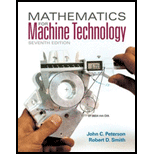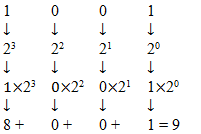
Concept explainers
Conversion of BCD (8421) numbers 11 0110 0101.0000 0111 to a decimal numbers.
Answer to Problem 21A
Decimal numbers is 365.0710.
Explanation of Solution
Given information:
A BCD (8421) numbers 11 0110 0101.0000 0111.
Calculation:
BCD number system uses 2 symbols: The numbers are 0 and 1.
And a decimal number system uses the number 10 as its base i.e. it has 10 symbols; decimal digits are 0, 1, 2, 3, 4, 5, 6, 7, 8 and 9.
BCD numbers are represented as from decimal number
| BCD (8421) | 0000 | 0001 | 0010 | 0011 | 0100 | 0101 | 0110 | 0111 | 1000 | 1001 |
| Decimal | 0 | 1 | 2 | 3 | 4 | 5 | 6 | 7 | 8 | 9 |
Each decimal digit consists of 4 BCD digits.
For example decimal number 9 is equal to BCD number 1001.
For converting integer part of BCD numbers into decimal numbers write down the BCD numbers and represent four binary digits from right by its decimal digit from the table.
Then combine all the digits together.
For converting fractional part of BCD numbers into decimal numbers write down the BCD numbers and represent four binary digits from left by its decimal digit from the table.
Then combine all the digits together.
Finally decimal number is combination of both integer and fractional part.
Decimal digits are equal to the summation of 2n where n = 0, 1, 2 and 3 (position from right)
For example 9 = 23+20; in this example 21 and 22 is not exist so at position 1 and 2 binary digit is zero and at position 0 and 3 binary digit is one; for example decimal of BCD 1001 is

The decimal number is equal to the summation of binary digits dn × 2n
Divide the binary number into block of four digits if four digits are not exist the add additional zero in binary number for example 11 is written as 0011 and .11 is written as .1100
Decimal of BCD number 11 0110 0101.0000 0111 is (Starting from right for integer part and starting from left for fractional part)
Want to see more full solutions like this?
Chapter 84 Solutions
Mathematics for Machine Technology
- Test data on the bending strength of construction wood poles of various diameter are presented below assuming the same length. Kip- 1000 lbf. Using the following data with 2nd order Newton polynomial interpolation, we want to determine the strength of the material for x=4.3 in. Which data point will be used as x0? After you found x0, enter the value of x-xo in the solution. Answer shall be in one decimal place. Distance (in) Strength (kips) 100 2.7 1 6.8 0.6 5.7 200 300 400 500arrow_forward2/2. prove that if G is Euler then so is L (G).arrow_forwardQ10. What are the chromatic numbers of the following two graphs? G H A. x(G) = 2 and x(H) = 2 B. x(G) = 2 and x(H) = 3 C. x(G) = 3 and x(H) = 2 D. X(G) = 3 and x(H) = 3 E. x(G) = 4 and x(H) = 3arrow_forward
- Q/prove that:- An edge only if e e of agraph G is abridge if and is not part of any cycle in G.arrow_forwardQ/ Give an Such that L(G) example of a simple graph G is Euler but G is not.arrow_forwardAttempted the problem with different numbers but got a row of zeros and does not match the answer provided; even with the free variables. I dont know what I'm doing wrongarrow_forward
- Let G be a graph with the following properties: G is simple, connected and planar. Every vertex of G has a degree of 4. Every face of G has three edges and every edge of G belongs to two faces. Does such a graph exist? If so, how many vertices, edges and faces does it have? (Hint: Turn each of the above property into an equation about the number of vertices, edges and/or faces of the graph.)arrow_forwardYou are provided with data that includes all 50 states of the United States. Your task is to draw a sample of: o 20 States using Random Sampling (2 points: 1 for random number generation; 1 for random sample) o 10 States using Systematic Sampling (4 points: 1 for random numbers generation; 1 for random sample different from the previous answer; 1 for correct K value calculation table; 1 for correct sample drawn by using systematic sampling) (For systematic sampling, do not use the original data directly. Instead, first randomize the data, and then use the randomized dataset to draw your sample. Furthermore, do not use the random list previously generated, instead, generate a new random sample for this part. For more details, please see the snapshot provided at the end.) Upload a Microsoft Excel file with two separate sheets. One sheet provides random sampling while the other provides systematic sampling. Excel snapshots that can help you in organizing columns are provided on the next…arrow_forwardThe University of the West Indies Open Campus ECON2016 Mathematical Methods of Economics II Final Assessment Instructions: Answer ALL the questions. Show all working 1. Solve the following Differential Equations a) dy = x²-1; y(-1) = 1 dx y²+1 dy b) d x + 2y = 3; dx c) dy-4y = 4y² dt d) 6dzy dx² dy -5+ y = 0; y(0) = 4 y'(0) = 0 dx [6] [5] [5] [6]arrow_forward
 Mathematics For Machine TechnologyAdvanced MathISBN:9781337798310Author:Peterson, John.Publisher:Cengage Learning,
Mathematics For Machine TechnologyAdvanced MathISBN:9781337798310Author:Peterson, John.Publisher:Cengage Learning, Algebra: Structure And Method, Book 1AlgebraISBN:9780395977224Author:Richard G. Brown, Mary P. Dolciani, Robert H. Sorgenfrey, William L. ColePublisher:McDougal Littell
Algebra: Structure And Method, Book 1AlgebraISBN:9780395977224Author:Richard G. Brown, Mary P. Dolciani, Robert H. Sorgenfrey, William L. ColePublisher:McDougal Littell Elementary AlgebraAlgebraISBN:9780998625713Author:Lynn Marecek, MaryAnne Anthony-SmithPublisher:OpenStax - Rice University
Elementary AlgebraAlgebraISBN:9780998625713Author:Lynn Marecek, MaryAnne Anthony-SmithPublisher:OpenStax - Rice University
 Holt Mcdougal Larson Pre-algebra: Student Edition...AlgebraISBN:9780547587776Author:HOLT MCDOUGALPublisher:HOLT MCDOUGAL
Holt Mcdougal Larson Pre-algebra: Student Edition...AlgebraISBN:9780547587776Author:HOLT MCDOUGALPublisher:HOLT MCDOUGAL




